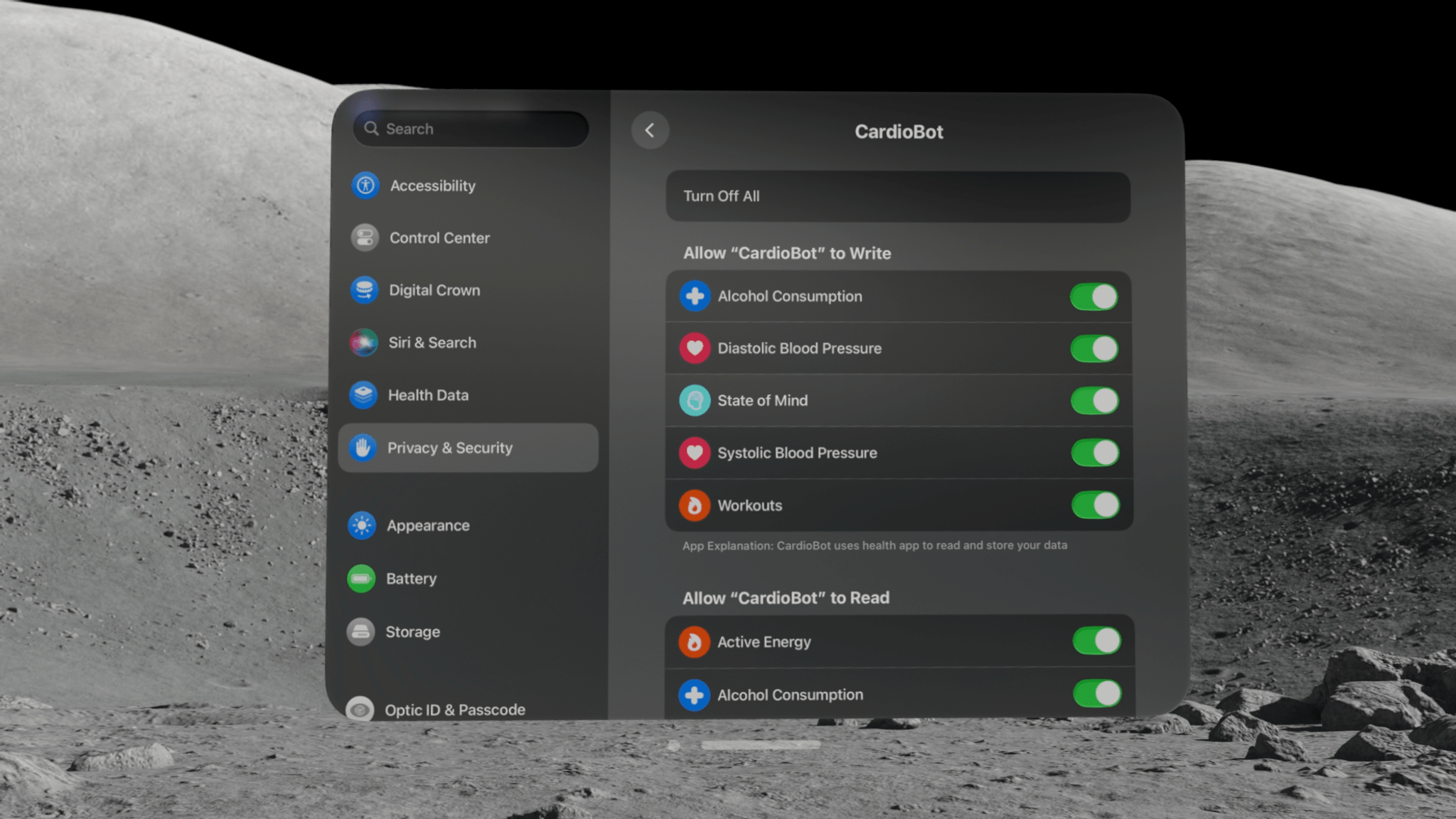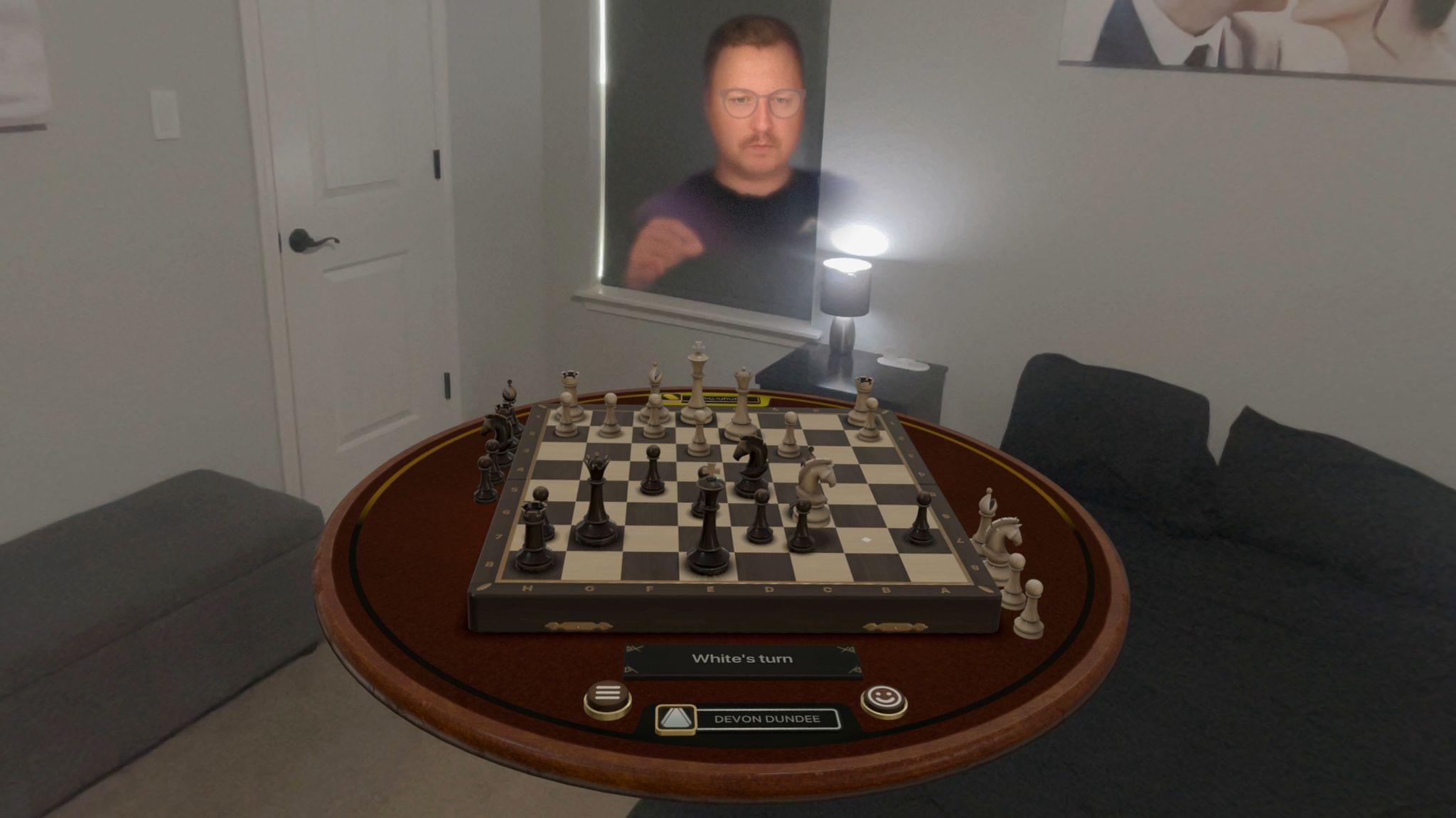Apps
Several system apps across Apple’s platforms are receiving new features and enhancements this year, and visionOS 2 benefits from the majority of them.7 Just to name a few:
- the all-new Passwords app spun out of Settings
- the Maps app’s new Library for saving locations, guides, and routes
- Math Notes, section folding, and text highlights in Notes
- integration of scheduled tasks from Reminders into Calendar
- tab bars for navigating system apps borrowed from iPadOS like Podcasts and News
- the new action library in Shortcuts
- compact view mode and persistent file downloads in Files
I’ll let Federico and John fill you in on all the details of system app updates that apply across platforms, but I do want to highlight a few visionOS-specific updates worth mentioning.
Safari
Watching Comfort Zone the way it deserves.Replay
Profile users, rejoice! Safari for visionOS now supports profiles, allowing you to separate your personal login credentials, browsing history, tab groups, bookmarks, extension settings, and more from your browsing for work, school, and other uses. There’s no sign of the Highlights or Distraction Control features added to other platforms this year, but the app does play a bit of catchup with pinned tabs and the ability to have Siri read a webpage to you. Safari can now display panoramic photos in immersive mode, too.
The biggest update to Safari in visionOS 2, though, pertains to video. Now, videos played in Safari can integrate into environments the same way videos from other apps can. This is important because major players like Netflix and YouTube have yet to develop apps for Vision Pro, so users have to watch those services in Safari instead. This change puts those viewing experiences on par with streaming apps, allowing them to be blown up to a gargantuan size and automatically placed within an environment for an ideal cinematic experience. This environment integration is also available for developers to add to video players in third-party apps.
TV
Speaking of cinematic experiences, Vision Pro is already the ideal way to watch films with its support for 4K, high dynamic range, 3D, spatial audio, and variable frame rates.8 It’s also the only place to experience Apple Immersive Video, the company’s 8K, 3D, 180-degree video format behind titles like Boundless and Prehistoric Planet Immersive, which is receiving a couple of updates this year.
You can now minimize immersive videos from full-screen view into a window. This allows users to enjoy the content without being fully immersed in it, and it’s also an alternate way to observe the 3D effects within the content.
On the accessibility side, captions can now be repositioned while watching immersive videos. Unlike traditional content, immersive video does not have a fixed point of view, and there’s action happening on all sides. That’s why it’s important that viewers who rely on captions be able to place them in whatever position works for their personal viewing needs and preferences. I’m thankful that Apple is continuing its work to ensure that spatial computing and immersive content are accessible to everyone.
The ‘Dim Flashing Lights’ setting is now available on visionOS as well. This is an important accommodation that was first added to the Apple TV last year, and it’s good to see it come to Vision Pro.
The TV app for visionOS will be adding support for Multiview later this year, allowing viewers to watch multiple sporting events at the same time. I’m a big fan of Apple’s Multiview implementation on Apple TV and iPad with easy source and layout switching, so I’m interested to see how this looks when it becomes available. I’m also curious to see when InSight, the feature that displays real-time information about actors, characters, and music onscreen, will come to visionOS after its launch on tvOS, iPadOS, and iOS this year.
Messages
Dictating a message, no pinch required.Replay
While Messages on visionOS 2 doesn’t include text effects or message scheduling like other platforms, it does add emoji Tapbacks and RCS support alongside a visionOS-exclusive feature this year: Look to Dictate. This option was previously available for Safari’s search bar and other search fields, but it’s now coming to the Messages composition field as well. Just look at the microphone icon to enter dictation mode and start speaking without the need to pinch your fingers together.
Mindfulness
The most relaxing thing you’ll see today – now synced to your breath.Replay
The Mindfulness app is one of the coolest experiences available on Vision Pro. It’s a true reimagining of what a meditation tool can be in an immersive environment. I find the digital petals floating around me to be both soothing and centering when it’s time for me to meditate. In visionOS 2, the movement of the petals and associated sounds can now be synced to your breath thanks to the new ‘Follow Your Breathing’ setting.
I don’t recommend replicating this experiment, but I tried enabling the feature and holding my breath during a meditation, and the animation held steady, waiting for me to exhale before starting its next motion. While I personally find that I benefit from a bit of guidance on my breathing rate when meditating, this is a good option for those who breathe more slowly or quickly than the predetermined guide and want the app to match their rhythm.
Developer Tools
Typically, a review like this one focuses exclusively on user-facing features, not behind-the-scenes tools for developers that users won’t ever use or potentially even recognize. In the case of visionOS 2, though, I think it’s worthwhile to point out a few new frameworks and APIs being made available to developers this year because they represent the evolution of the platform and the direction Apple believes spatial computing is headed. These additions aren’t necessarily things you’ll find in operating system feature lists, but they set the foundation for new types of apps and experiences in visionOS that will be important for the platform’s future.
I didn’t expect HealthKit to come to visionOS so quickly based on how long it took Apple to bring the feature to iPad, but I’m pleasantly surprised that it’s coming in visionOS 2. Now, apps on Vision Pro can request users’ permission to access, display, and update their health data. This makes the platform more viable for developers of health- and fitness-focused apps. I hope to see more apps in these categories in the Vision Pro App Store soon.
Apple isn’t taking the lead in these categories on the platform, though. Neither the Health app nor the Fitness app are included in visionOS 2, which is a shame. This lack of first-party apps in the health and fitness categories could be an opportunity for third-party developers to fill the gaps and create compelling experiences that entice new users.
Developers can now set the position of new apps windows when they appear, an improvement over the previous sytem that always opened windows directly in front of the user’s gaze. Windows placement can be set relative to existing windows in the space or relative to the user. A new option called ‘push window’ allows an app to open a new window in the place of an existing one, covering up the original window. New window controls may not be the most exciting addition to an operating system, but these options empower developers to create more tailored experiences for users of their apps, which is always a good thing.
The majority of the new developer tools in visionOS 2 pertain to augmented reality. Room tracking lets developers know when a user enters a new room, and apps can respond accordingly.9 The system is now capable of detecting not only horizontal and vertical surfaces, but slanted ones as well, giving developers a fuller understanding of the space around the user. Volumetric apps can be opened alongside other apps, and they can be resized, tilted, and customized with ornaments.
Apple’s virtual teacup looks great next to my Stanley.Replay
Virtual objects can be attached to physical surfaces within a room, too. I was able to test this feature by opening a USDZ file for a 3D object in Quick Look and moving it around the room. As you move an object close to the level of a table or the floor, it will snap to that surface with a satisfying clicking sound. Then, you can slide that object around the surface and put it exactly where you like.
Once an object is in place, it does not move at all. You can walk around it, look away from it then back, and even leave the room and come back later, and the object will stay precisely in place no matter what. It truly is remarkable how stable these virtual objects are, and it makes them feel integrated with the physical world in a much deeper way than was possible before. Apps that place virtual objects within the user’s environment will be able to give much more realistic impressions thanks to these improvements.
Meanwhile, new object tracking APIs allow developers to use physical objects as anchors for virtual elements. Imagine buying a physical product that comes bundled with a visionOS app for augmenting and interacting with it, or an app that identifies objects within your space and lets you select them to learn more about them. These are the kinds of experiences made possible by object tracking, and I’m excited to see how developers put these tools into practice.
TabletopKit makes it easier for developers to create spatial experiences based around a table. One of the coolest things I’ve ever done with my Vision Pro is playing board games with a friend in Game Room from Resolution Games via SharePlay. It does an incredible job of replicating the experience of sitting across from someone while playing a tabletop game together, and TabletopKit will enable more developers to create experiences like this. Apple featured indie game studio GRL Games’ upcoming title Haunted Chess in the WWDC keynote as an example of TabletopKit in action. I hope to see a lot of these types of games available on the platform before long.
These new developer tools follow the same pattern as the user-facing quality-of-life improvements in visionOS 2: they seem like table stakes10 in a vacuum, but when considered within the short history of visionOS, they represent a rapid pace of change in response to users’ experiences and developers’ needs. Together, they form a more complete foundation for building spatial computing applications that in turn offer more immersive, enjoyable, and beneficial experiences for users. A feature like room tracking might not seem like such a big addition now, but it will likely be considered an essential element of spatial computing in the future. And thanks to these new tools and the developers implementing them, that future starts now.
- Alas, visionOS does now remain the sole Apple platform without a built-in calculator app. ↩︎
- The platform could still win some extra points with film buffs, though, by adding support for watching iTunes Extras bundled with film purchases and giving users a path to upgrade 2D titles imported from other storefronts via Movies Anywhere to 3D. ↩︎
- The example use case Apple gives for this technology is a virtual pet that abides within a particular room and greets you when you enter it, and I want to buy this app immediately. I really hope there’s a developer out there working on it. ↩︎
- Pardon the pun. ↩︎





